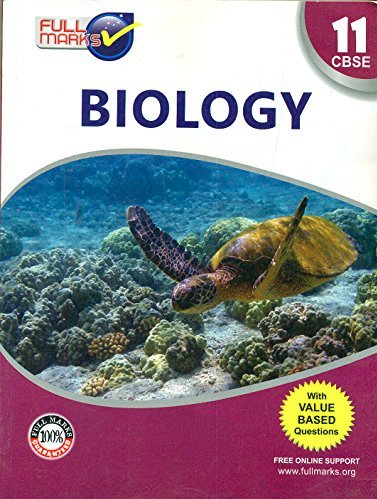1. Choose the correct answer among the following:
(a) Gastric juice contains
(i) pepsin, lipase and rennin
(ii) trypsin, lipase and rennin
(iii) trypsin, pepsin and lipase
(iv) trypsin, pepsin and renin
(b) Succus entericus is the name given to
(i) a junction between ileum and large intestine
(ii) intestinal juice
(iii) swelling in the gut
(iv) appendix
Solution:
The correct answer is as follows:
1. Gastric juice contains(i) pepsin, lipase and reninLipase disintegrates fats into fatty acids. Renin brings about the coagulation of milk as it is a photolytic enzyme present in the gastric juice. Pepsin is produced in an inactive form, pepsinogen that is activated by HCl. Pepsin digests proteins into peptones.
2. Succus entericus is the name given to(ii) Intestinal juiceIntestinal juice is also known as succus entericus, which is produced by the intestinal gland. Succus entericus contains different enzymes such as maltase, lipases, dipeptidases, nucleosides to name a few.
2. Match column I with column II
Column I
Column II
(a) Bilirubin and biliverdin
(i) Parotid
(b) Hydrolysis of starch
(ii) Bile
(c) Digestion of fat
(iii) Lipases
(d) Salivary gland
(iv) Amylases
Solution:
Column I
Column II
(a) Bilirubin and biliverdin
(ii) Bile
(b) Hydrolysis of starch
(iv) Amylases
(c) Digestion of fat
(iii) Lipases
(d) Salivary gland
(i) Parotid
3. Answer briefly:
(a) Why are villi present in the intestine and not in the stomach?
(b) How does pepsinogen change into its active form?
(c) What are the basic layers of the wall of alimentary canal?
(d) How does bile help in the digestion of fats?
Solution:
1. In the small intestine, the presence of villi causes an increase in the surface area for further efficient absorption of food. Since absorption of food mainly occurs in the small intestine, villi is found to be present in the intestine and not in the stomach.
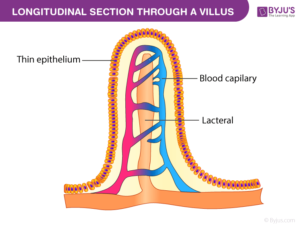
2. Pepsinogen is accumulated in the stomach walls and is a precursor of pepsin. Pepsinogen is converted into pepsin by the action of hydrochloric acid. Hence, the activated form of pepsinogen is pepsin.

3. The basic layers of the walls of the alimentary canal are four, namely:
Serosa – The outermost layer of the human alimentary canal, it consists of a fine layer of secretory epithelial cells with a few underlying connective tissues.
Muscularis – it is a layer of thin, smooth muscles that is arranged into an outer layer that is longitudinal, and an inner layer that is circular
Sub-mucosa – it is a layer of loose connective tissue that contains the following – lymph vessels, nerves and blood. The sub mucosa supports the mucosa.
Mucosa – it is the innermost lining of the lumen of the alimentary canal which is chiefly involved in the processes of absorption and secretion.
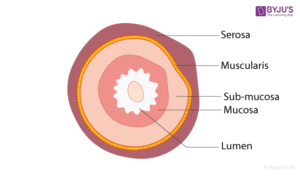
4. Bile brings about the digestion of fats. It is a digestive juice that is produced by the liver and accumulated in the gall bladder. The bile juice contains bile salts such as biliverdin and bilirubin which disintegrates large fat globules into smaller globules for pancreatic enzymes to act on them easily. The phenomena is termed as emulsification of fats. The bile juice is also known to make the medium alkaline and to activate lipase.
4. State the role of pancreatic juice in digestion of proteins.
Solution:
Pancreatic juice consists of several inactive enzymes, to name a few – chymotrypsinogen, trypsinogen, pro carboxypeptidases, lipases, nucleases and amylases which play a crucial role in the process of protein digestion.
Digestion of proteins:
Enterokinase, an enzyme is produced by the intestinal mucosa. This enzyme activates trypsinogen into trypsin.
![]()
Subsequently, trypsin activates other enzymes of the pancreatic juices such as pro carboxypeptidase and chymotrypsinogen. Chymotrypsinogen is an enzyme that coagulates milk and converts proteins into peptides.
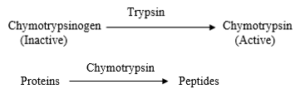
Carboxypeptidases acts on carboxyl part of the peptide chain which promotes the release of the last amino acids. Therefore, it enables in the protein-digestion
![]()
Therefore, the partially hydrolyzed proteins that are found in chyme are acted upon by different
proteolytic enzymes of the pancreatic juice for complete digestion.
![]()
5. Describe the process of digestion of protein in stomach.
Solution:
The process of digestion of proteins is initiated in the stomach and terminates in the small intestine. The digestive juices that are produced in the gastric glands found on the walls of the stomach is referred to as gastric juice. The food that moves in to stomach turns acidic when it gets mixed with this gastric juice.
The chief components of gastric juices are renin, pepsinogen, mucus and hydrochloric acid. Hydrochloric acid liquefies or dissolves the food bits, generating an acidic medium in order to convert pepsinogen into pepsin. Pepsin is an enzyme that digests proteins and is secreted as pepsinogen, that is in its inactive form, which gets activated by the action of hydrochloric acid. This activated pepsin then converts proteins into proteases and peptides.

6. Give the dental formula of human beings.
Solution:
The dental formula of human beings is a way of expressing the teeth arrangement in each of the upper jaw and lower jaw. The whole formula is then multiplied by two in order to get the total number of teeth in human beings.

To elaborate, each half of the upper and lower jaws has 2 incisors, 1 canine, 2 premolars and 3 molars. Hence, an adult human being ideally has 32 permanent teeth.
7. Bile juice contains no digestive enzymes, yet it is important for digestion. Why?
Solution:
Bile juice is important for digestion. It is a digestive juice that is produced by the liver. Even though it has no digestive enzymes, it has a critical role to play in fat-digestion. Bilirubin and biliverdin are the two bile salts that is present in bile juice, which disintegrates large globules into smaller globules such that the pancreatic enzymes can act on them easily. This phenomena is referred to as emulsification of fats. The bile juice is also known to make the medium alkaline and is involved in the activation of lipase.
8. Describe the digestive role of chymotrypsin. Which two other digestive enzymes
of the same category are secreted by its source gland?
Solution:
Pancreatic juice consists of an enzyme known as the trypsin which activates the inactive enzyme known as the chymotrypsinogen to chymotrypsin.
![]()
This activates chymotrypsin is critical in further disintegrating the partially-hydrolyzed proteins.
![]()
Trypsinogen and carboxypeptidase are the two other digestive enzymes belonging to the same group which are secreted by the pancreas.
9. How are polysaccharides and disaccharides digested?
Solution:
Carbohydrates are digested in regions of alimentary canal, small intestine to be specific and in the mouth. Carbohydrates are acted upon by enzymes which are collectively known as carbohydrates.
Carbohydrate digestion in the mouth:
When the food enters the mouth, it gets mixed with the saliva,that is produced by the salivary glands. The salivary glands consists of salivary amylase, which is a digestive enzyme, responsible in disintegrating starch into sugar at the pH level, 6.8.

This enzyme, the salivary amylase continues its action in the esophagus, but remains ineffective in the stomach as the contents turn acidic. This is why digestion of carbohydrates stops in the stomach.
Carbohydrate digestion in the small intestine:
Small intestine is the site where the digestion of carbohydrates resume. In this part, the food gets mixed with the intestinal and pancreatic juices. The pancreatic juice consists of the pancreatic amylase which hydrolyzes the polysaccharides into disaccharides.
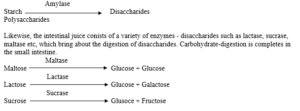
10. What would happen if HCl were not secreted in the stomach?
Solution:
The walls of the stomach secrete hydrochloric acid, which dissolves fragments of food and builds an acidic environment. This medium facilitates the conversion of pepsinogen into pepsin. Pepsin plays a crucial role in protein-digestion.
Pepsin would be inactivated if HCl were not to be secreted in the stomach which would have an effect on the digestion of proteins. In order for the proteins to be digested, a pH of 1.8 is essential, which is provided by HCl.
11. How does butter in your food get digested and absorbed in the body?
Solution:
Butter is a fat product that gets digested in the small intestine. After the process of emulsification of fats, the pancreatic juice containing the pancreatic lipase and the intestinal juice containing intestinal lipase hydrolyze the molecules of fat into diglycerides, triglycerides, monoglycerides and finally into fatty acids and glycerol.

Fat absorption:
It is an active process during which the fats are hydrolyzed into glycerol and fatty acids. As these are
water soluble, they are directly not absorbed by blood. They are incorporated first into small droplets known as micelles and then shifted to the villi of the intestinal mucosa, where they reform as chylomicrons, tiny microscopic particles. They are tiny, protein-coated fat globules that are transported to the lymph vessels in the villi. The food that is absorbed from the lymph vessels ultimately, is liberated into the blood stream and furthermore to each cell of the body.
12. Discuss the main steps in the digestion of proteins as the food passes through
different parts of the alimentary canal.
Solution:
The process of protein-digestion is initiated in the stomach and terminates in the small intestine. Proteases are the enzymes that act on proteins. The proenzyme, pepsinogen in the stomach gets converted into pepsin that acts on proteins to bring about its conversion into peptone.
![]()
Some of the enzymes found in the pancreatic juice in their inactive form are trypsinogen, procarboxypeptidases and chymotrypsinogen. Enterokinase, an enzyme that activates trypsinogen is produced by the intestinal mucosa into active trypsin which further activates other enzymes in the pancreatic juice. Procarboxypeptidases and Chymyotrypsinogen are converted into carboxypeptidase and chymotrypsin by the action of trypsin. Chymotrypsin results in the formation of peptides from proteins and carboxypeptidase converts peptides into tiny peptide chains and amino acids.
13. Explain the term the codont and diphyodont.
Solution:
Every tooth in human beings is embedded in a socket of the jaw bone. This attachment of teeth is referred to as codont.
Most of the mammals and human beings produce two sets of teeth in their life time. First, as a set of milk teeth or deciduous teeth which are temporary and second a set of adult teeth that are permanent. The temporary milk teeth are replaced by the permanent adult teeth. This dentition is referred to as diphyodont.
14. Name different types of teeth and their number in an adult human.
Solution:
In an adult human, there are four different types of teeth. They are:
Type of the teeth
Location/Characteristic
Total
Occurrence in Lower jaw
Occurrence in upper jaw
Function
Incisors
Present in the front
8
4
4
Meant for cutting
Canines
Pointy teeth found on either side of the incisors
4
2
2
Meant for tearing
Premolars
Found next to canines
8
4
4
Meant for grinding
Molars
Found at the end of jaw, adjacent to the premolars
12
6
6
Chewing and grinding food
![]()

